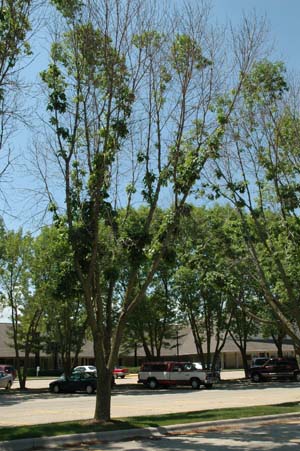Decline of Ash/from issue no. 8 | |
|---|---|
| June 13, 2006 | |
The usual variety of plant problems has arrived at the University of Illinois Plant Clinic this spring. Ash samples have been among those of concern to home-owners and landscapers. Although some people are concerned with current leaf drop due to anthracnose, others are seeing a more chronic problem of ash decline. Anthracnose was discussed in issue no. 5 of this newsletter. Trees infected with ash anthracnose should be improving now as new leaves emerge in warmer temperatures. Trees with ash decline may not be faring so well. Conditions worsen with hot, dry weather. Ash decline is a term often used loosely by many diagnosticians to refer to more than one condition. Ash decline might involve an infectious disease such as ash yellows disease or Verticillium wilt, an insect such as an ash borer, or environmental stress such as deep planting or girdling roots. Ash decline is a term used to indicate any decline of ash for which a single pathogenic cause has not been identified. Ash decline is a chronic problem, involving more of the tree over many years. It usually includes branch tip death, defoliation of branches to give the tree a sparse look, and a slow decline of the tree’s vitality. Trees with ash decline may appear to be recovering each year in the spring and then decline once heat and drought occur. There is no easy cure for ash decline. Fungicides are not beneficial. Insecticides may help if a specific insect is identified. In general, for most ash problems, management is simply to remove dead wood and promote tree health through watering, mulching, and fertilization practices. Ash yellows is the disease that probably most resembles ash decline. This disease primarily affects white and green ash in the north-central and northeastern parts of the United States. It is a problem in Illinois, but one that is difficult to quantify because its presence is difficult to confirm. Ash yellows disease is caused by a phytoplasma (formerly called mycoplasma-like organism, or MLO). These pathogens are somewhat like virus particles, cannot be cultured in a lab, and are spread by phloem-feeding insects. They are limited to the phloem tissue of the tree. This disease is characterized by a loss of vigor over a period of 2 to 10 years before the tree dies, much like ash decline. Symptoms include short internodes (poor growth) and tufting of foliage at branch ends. Leaves become pale green to chlorotic (yellowed) and might develop fall colors prematurely. The tree may or may not defoliate, but the canopy generally appears sparse (as with ash decline). Cankers form on both branches and the trunk, causing twigs and branches to die back (as with ash decline). Witches’-broom sprouts of growth might appear on some branches but are more common on the trunk near the ground. Cracks in the trunk may appear in this area as well. It is rare for an ash tree to recover from ash yellows. A great percent of the ash trees in Illinois landscapes are green ash. They do not show ash yellows symptoms as clearly as white ash. It is very likely that this yellows disease is more common than we realize because the typical witches’-brooms and yellowing are not always seen with green ash, even when the disease is present. Instead we see only the cankers and stem dieback, conditions that suggest ash decline. The ash yellows phytoplasma cannot be cultured in the laboratory on artificial media. Some testing services that offer specific PCR (polymerase chain reaction) tests can detect phytoplasmas in plant tissues. This is not a service currently offered at the University of Illinois Plant Clinic. AGDIA, Inc., a private company in Indiana, has such a service. You can read about AGDIA on the Web at http://www.agdia.com/. There are likely other labs that can help. The cost for phytoplasma testing varies with the number of samples being tested. Turn-around time also affects the cost; so if you need results quickly, it costs more. For this test, AGDIA would need live, thick bark from the base of the tree. It must include phloem tissues and be deep enough to prevent phloem tissue from drying out. It is advised that you call the testing service of choice before sending a sample. It is obvious why this disease has not been confirmed frequently in Illinois. Verticillium wilt on ash also results in cankers and dieback and does not cause the typical vascular discoloration of most Verticillium infections. Refer to Report on Plant Disease, no. 1010, http://www.ag.uiuc.edu/%7Evista/horticul.htm, for more information on Verticillium wilt. It is difficult and time-consuming to distinguish between ash yellows, Verticillium wilt, and ash decline in Illinois. Diagnosis of these ash problems is dependent almost entirely on symptoms that could be caused by a variety of problems. At the Plant Clinic, Verticillium can be detected by traditional laboratory isolations of fresh, live-leaf petioles from symptomatic branches. Ash decline cannot be confirmed with laboratory isolations but can be diagnosed based on symptoms and adequate facts. Sometimes Verticillium is involved, sometimes ash yellows, and always some sort of site or environmental stress. | |
| Author: | Nancy Pataky |
